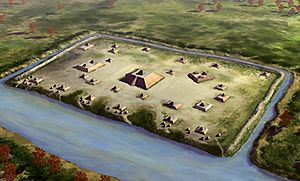Quigualtam facts for kids
Quigualtam, also called Quilgualtanqui, was a strong Native American group. It was part of the Plaquemine culture. Explorers led by Hernando de Soto met this group in 1542–1543.
The main settlement and its leader were also named Quigualtam. However, de Soto's group never actually visited them. They only exchanged messages through runners. They also had a three-day canoe battle on the Mississippi River.
Historians and archaeologists have tried to figure out who Quigualtam was. They have looked at different ancient cultures and sites. But it's hard to be completely sure about their exact identity.
Contents
Where Was Quigualtam Located?
Experts have different ideas about where Quigualtam was. They also debate the exact location of its main settlements.
Historian Charles M. Hudson thought Quigualtam was near the Holly Bluff site or Winterville site. These sites are in the lower Yazoo Basin. However, archaeologists believe these large Plaquemine culture sites were empty by 1542. The main settlement likely moved to another place in their territory.
Other Possible Locations
Other experts have suggested the Glass site and Emerald Mound. The Glass site is near Vicksburg, Mississippi. It was on the northern edge of the Emerald Phase (1500–1680). This was a time when the Natchez chiefdom was developing.
During this period, the Natchez capital was at the huge Emerald Mound. This mound is near Stanton, Mississippi. The Glass site and Emerald Mound were the only major centers in that part of the Mississippi River. They were active between 1500 and 1650 CE.
The Spanish explorers never landed to leave proof of contact. So, we may never know for sure if these were Quigualtam's sites.
What Happened After the Spanish Left?
Europeans did not contact the people in this area again for almost 140 years. The first French explorers arrived in the 1680s. By then, the Natchez people's main power center had moved. It shifted from Emerald Mound to the Grand Village of the Natchez. The Glass site was also empty.
Challenges for Native Peoples
Native people in the region faced many problems. They caught new diseases from de Soto's expedition. These diseases spread easily among them. The Spanish also used local rivalries to their advantage. This upset the balance between native groups. These groups had often been in small conflicts for many years.
Also, there were severe droughts for many years in the late 1500s.
Many societies in the region began to fall apart. Some groups of Mississippian peoples moved across the Mississippi River. They sometimes settled in areas left empty by Plaquemine peoples. Other times, they joined or pushed out Plaquemine groups. The Plaquemine culture moved south. They completely left the northern Natchez Bluffs.
The Lower Yazoo basin region was once home to Winterville and Holly Bluff. Later, it became the land of the Yazoo, Tunica, and Koroa tribes. These tribes had moved from further upriver. Archaeologists think they were descendants of groups de Soto met near Memphis, Tennessee. They were escaping the destruction left by de Soto's journey.
The Tioux and Grigra groups of the Natchez were new additions. They were also Tunica speakers from up the river. They had been adopted into the Natchez tribe.



